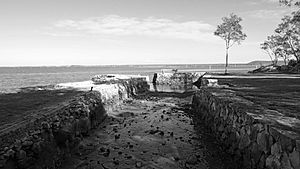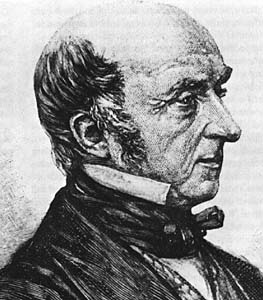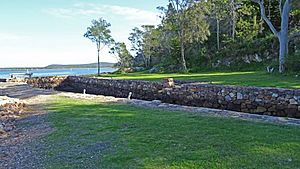Tahlee facts for kids
Quick facts for kids Tahlee |
|
|---|---|

Tahlee Homestead, 2017
|
|
| Location | Tahlee Road, Tahlee, Mid-Coast Council, New South Wales, Australia |
| Built | 1826–1888 |
| Owner | North Arm Cove Properties Pty Ltd; Tahlee Gospel Ministries |
| Official name: Tahlee Bible College; Tahlee House; Tahlee Estate; Carrington Archaeological Site; Australian Agricultural Company | |
| Type | state heritage (landscape) |
| Designated | 2 April 1999 |
| Reference no. | 569 |
| Type | Historic Landscape |
| Category | Landscape - Cultural |
| Builders | Australian Agricultural Co., Sir Edward Parry, RHD White |
| Lua error in Module:Location_map at line 420: attempt to index field 'wikibase' (a nil value). | |
Tahlee is a special historical place in New South Wales, Australia. It's located on the north side of Port Stephens, near Karuah. This area was once a huge farm owned by the Australian Agricultural Company. Later, it became home to the Tahlee Bible College. Tahlee is so important that it's listed on the New South Wales State Heritage Register.
Contents
Discovering Tahlee's Past
Early Days at Tahlee
The first people to live in this area were the Worimi tribe. The name "Tahlee" comes from their language. It means "sheltered from the wind and above water."
European Explorers Arrive
Captain James Cook first saw Port Stephens in 1777. He named it after Philip Stephens, a government official. Later, in 1795, Charles Grimes explored the area. His report wasn't very positive at first.
The Australian Agricultural Company
In 1824, a big company called the Australian Agricultural Company (AACo.) was started in London. People wanted Australian wool, so this company was created to raise sheep in Australia. The AACo. became very important for Australia's coal and farming industries. It helped settle and develop the Hunter River and Port Stephens areas. It's still operating today under its original name!
How the Company Started
The company was given special permission by the King of England. They could own and sell land in New South Wales. The plan was to use convicts for most of the work. Skilled workers from England would supervise them. If the company spent enough money and employed enough convicts, they would own the land forever. They were promised one million acres!
The company chose Robert Dawson as their main agent. In 1825, Dawson sailed from England with many employees, sheep, cattle, and horses.
Choosing Port Stephens
In 1826, Dawson explored Port Stephens. He found a perfect spot on the northern shore. It had good land for growing crops and hills for sheep. There was also fresh water and materials for building. It was all located on a beautiful harbour. Dawson decided this was the ideal place for the company's huge land grant.
The settlement at Port Stephens was first called Caribbean by the local Aboriginal people. It was later renamed Carrington. Tahlee House became the first main office for the AACo. It was home to four of the company's chief agents: Dawson, Parry, Dumaresq, and King.
Within four years, by 1830, Carrington village was a planned town. It had over 500 people and a school.
The original Carrington village had a military barracks, cottages, a shearing shed, and workshops. It also had a jail and two wharves.
Expanding the Company's Reach
Dawson named many places after the company's directors. For example, the village of Stroud was named after a town in England. By the end of 1826, the company had sheep stations from Carrington to the Gloucester River.
Tahlee Estate was the AACo.'s first headquarters. It was the first European settlement in the area. There was a lot of interaction with the local Aboriginal people. The Commissioner's house was built here. Workers lived in nearby Carrington village.
New Leaders and New Challenges
Robert Dawson was dismissed in 1828. Then, Sir William Edward Parry, a famous Arctic explorer, became the next commissioner in 1829. Parry arrived at Tahlee in 1830. He worked to improve the settlement. He also explored new land for the company.
Parry was a very religious man. He started Sunday services in the carpenter's shop. In 1833, he built St John's church in Stroud. Lady Parry, his wife, opened a school for children. She also started a school for prisoners who wanted to learn to read and write.
Parry also helped set up the coal mine in Newcastle. The company was given a 32-year monopoly on coal mining in New South Wales. This meant they were the only ones allowed to mine coal for a long time.
Life at Tahlee was happy during the Parrys' time. They held cricket matches, dinners, and picnics. Sir Edward felt responsible for the well-being of the nearly 500 people on the estate.
When Parry left, the farming and mining operations were doing well. But the company still struggled to find enough workers.
In 1834, Captain Henry Dumaresq took over from Parry. The company continued to do well. They even paid their first dividend to shareholders.
Changes and Difficulties
A track was built from Gloucester to Tamworth. This allowed sheep to be moved for washing and shearing. By 1849, the company had 85,000 sheep. They also bred horses for the Indian army.
But with the end of convict transportation, it became very hard to find workers. They constantly asked London for shepherds and miners.
Dumaresq died in 1838. Captain Phillip Parker King (son of Governor Philip Gidley King) became the new commissioner. This was a tough time. There was an economic downturn and a drought, followed by floods.
The company tried to bring in Irish workers, but it didn't go well. Many refused to work as shepherds. However, other groups of workers from Britain were more successful. By the late 1840s, most of the company's workers were free men, not convicts.
During King's time, other groups wanted to mine coal. This challenged the AACo.'s coal monopoly. The company also had trouble getting the full ownership of their land. They hadn't used as many convicts as planned.
Eventually, a new law was passed in 1846. This freed the company's land from the old rules. They also got full ownership of their coal lands in Newcastle.
The company thought about selling some of its land. King suggested selling the large land grants in sections. He believed Port Stephens wasn't good for small farms.
In 1852, gold was found on the Peel River. This made the company's share price jump! The company formed a new group, the Peel River Land & Mineral Company, to work the gold. But this venture had many problems.
The Port Stephens area turned out to be too wet for sheep. So, in 1854, the AACo. bought better land in the Peel Valley. Captain Phillip Parker King was the last AACo. commissioner to live in Tahlee House. The company's main office moved to Stroud in 1853. The Tahlee Estate was then sold to Robert Hoddley Driberg White.
After the Australian Agricultural Company
In 1854, Frederick Manton bought Tahlee from the AACo. His family used it for grazing animals. Sadly, the house burned down in 1860, leaving only the walls.
The White Family Era
In 1880, Robert Hoddle Driberg White bought the property. He was a Member of Parliament. He rebuilt Tahlee House into a grand country home. The house you see today is mostly from his time.
White's father had worked for the AACo. Robert H. D. White was a lively person who owned two private steam yachts. He rebuilt Tahlee House to host fancy parties.
He made many improvements. He added a billiard room and a ballroom. Marble for the fireplaces came all the way from Italy! Twelve full-time gardeners looked after the beautiful terraced gardens.
Guests would arrive by yacht at the convict-built boat harbour. Then, a horse-drawn tram would take them up the hill through amazing gardens. These gardens had unique trees like New Zealand kauri trees and Japanese elms.
White added a large lounge room for entertaining. He also built a separate billiard room (now a chapel) and a ballroom that could hold about 300 people. The boat harbour, wine cellar, and servants' quarters still remind us of the AACo. days.
After White died, the estate was kept for his wife. Then it went to their son, Alfrey Beecher Stewart White. He used Tahlee House as a country getaway.
The Gospel Fishermen Mission
In 1943, a group called the Gospel Fishermen Mission moved to Tahlee. They had a mission to spread their Christian message. They used "Gospel Vans" to visit isolated areas. They also held big meetings and children's camps.
In 1949, the mission leased the Tahlee property as a camp center. The Theobold family, who led the mission, moved into a cottage there. They started using the ballroom and billiard room. In 1951, they set up a training camp for missionaries.
Mr. White, the owner, continued to visit Tahlee House. In 1959, he offered to sell the property to the Mission. A large donation made it possible for them to buy it.
Tahlee Bible College
In 1959, Tahlee became a Bible College. Rev Eric Potter was the first Principal. Over 1,000 students have trained there. Many of them now work in Christian service around the world. The property has been greatly improved over the years.
The college focused on running camps and events for children, young people, and families. You can still take tours of the historic buildings.
In 1964, some buildings from old migrant camps were moved to Tahlee. They were used for student housing.
Today, the site is known as Tahlee Ministries Inc. It stopped operating as a full-time Bible college around 2005. However, it is still used by Tahlee Ministries for religious purposes. You can visit by arranging it beforehand.
What Tahlee Looks Like
Tahlee is a large rural estate, about 44 hectares (108 acres). It was the first main office of the Australian Agricultural Company from 1826 to 1853.
Important parts of Tahlee include:
- Tahlee House and its smaller buildings (built between 1828 and 1888).
- The Boat Harbour (built in 1828).
- The beautiful gardens (from the 1830s to 1890s).
- The caretakers cottage (from 1890).
- The Reception and Ballroom building (built 1888–90).
- The Residential Bible College buildings (from 1959–99).
- Relocated Nissen Huts and a Cinema from the Greta Migrant Camp (moved in 1964).
The buildings are in different conditions, some good, some needing work. The area also has a high chance of having important historical items buried underground.
Why Tahlee is Important
Tahlee Estate is very important for understanding Australia's history. It shows us about life before Europeans arrived and how European settlement began. We can still see evidence of how the estate was used in the past.
Tahlee was added to the New South Wales State Heritage Register in 1999 because:
It shows how New South Wales history unfolded. It was the first settlement site for the Australian Agricultural Company. This company was key to NSW's early economy. Important areas like Gloucester and the Peel River were settled from here. It's also a significant site of early Aboriginal life. This place saw an early positive meeting with local Aboriginal people. Records from people like Robert Dawson help us understand the Gringai people who lived here. Many important people in Australian history were linked to Tahlee, like John Macarthur, Sir Edward Parry, and Phillip King.
It has beautiful design and great achievements. The house and gardens show the style of the people who lived there. They were designed to enjoy the views. The remains of boating areas, terraced gardens, and bathing spots show how people had fun here. Famous artists like Augustus Earle painted Tahlee.
It has a strong connection to different groups. People in NSW value Tahlee as the original site of the AACo. It was also home to RHD White, a well-known local figure. Christian communities in NSW also value Tahlee. This is because of its connection to Christian leaders like Sir Edward and Lady Parry, and the Gospel Fishermen Mission. This is why it continued to be used as a Bible College.
It can teach us more about history. Tahlee is an important site of European settlement from 1826. There are enough old buildings and records to understand how the settlement grew. The boat harbour shows how important sea travel was back then. The site's long history (164 years) helps us understand how life changed over time. The Observatory shows Phillip King's interest in science and how much boating happened in the port. The terraced gardens show a high level of gardening skill. The grazing land reminds us of the large farms that used to be common in Port Stephens.
It has rare parts of history. Tahlee is a rare and complete record of 164 years of European development. Its gardens are especially rare because they are so well-preserved.
It represents important types of historical places. The estate shows what the Australian Agricultural Company's work in NSW was like.




